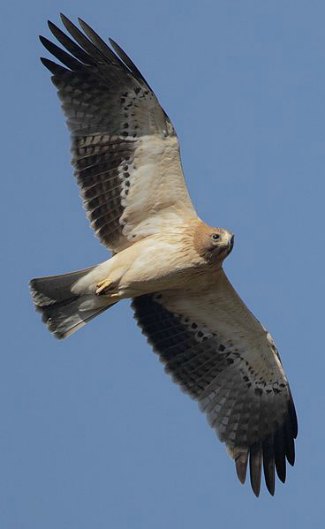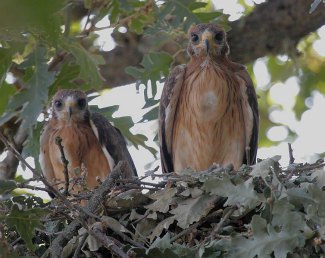Booted Eagle - Aquila pennata
By Juan Lacruz, CC-BY-SA-3.0, via Wikimedia Commons
Family: Accipitridae
Genus: Aquila
Species: A. pennata
Subspecies: A. p. harterti, A. p. minisculus, A. p. pennatus
Booted Eagles are small to medium-sized brown eagles with a large range across several continents. They form a clade with Aquila ayresii (Ayres’s Hawk Eagle) and Aquila morphnoides (Little Eagle). Aquila wahlbergi (Wahlberg’s Eagle) is a sister species.
Physical Description:
Booted Eagles are dimorphic, with a pale morph and dark morph form; the dark morph is less common. Pale morphs have streaked white underparts, dark gray to brown upperparts, and black flight feathers. The wings have lighter areas across the coverts and scapulars, and so-called "headlights" or small white patches where the wings meet the body. The head is cream- to gold-colored with dark cheeks. Dark morphs are almost identical except for dark underparts with black streaks and lighter spots and streaking along the thighs and crissum. Some dark morphs are rufous brown. The eyes are yellow-brown, orange-brown, or red-brown, the cere and feet are yellow, and the legs and tarsi are feathered.
Booted Eagles are similar to many other raptors, potentially leading to misidentification. Pale morphs superficially resemble the Wahlberg’s Eagle (Aquila wahlbergi), the juvenile Ayres’s Hawk Eagle (Aquila ayresii), Western and Eastern Honey Buzzards (Pernis apivoris and Pernis ptilorhynchus), the Common Buzzard (Buteo buteo), along with the Egyptian Vulture (Neophron percnopterus) and other pale raptors. Dark morphs are similar to the Black Kite (Milvus migrans), the juvenile Northern Marsh Harrier (Circus cyaneus), and dark morph Wahlberg’s Eagles.
Juveniles are not highly different from adults and can be hard to distinguish. They usually have rufous underparts and a reddish head, and the eyes are gray-brown.
Calls of Booted Eagles are a rapid "kli kli kli".
They can live up to 12 years in captivity.
Size:
Length: 46-53 cm
Wingspan: 110-135 cm
Weight: 0.6-1.2 kg
Habitat and Distribution:
Booted Eagles live in a wide range of habitats at 0-3,000 meters above sea level, usually around 300-1,200 m. They occupy open coniferous and deciduous woodland, desert and semi-desert, grassland, sea cliffs, and mountainous regions with cliffs and dry scrub. They also live in cultivated areas such as eucalyptus plantations. Wintering birds from Palearctic regions tend to prefer flat plains and open woodland.
By Juan Lacruz, CC-BY-SA-3.0, via Wikimedia Commons
Their range spans from southern Europe to southern Central Asia and the Middle East, with a narrower range extending across Iran, the Himalayas, and Mongolia. There are also breeding populations in Namibia and South Africa. Eurasian populations are migratory and winter in sub-Saharan Arica and the Indian subcontinent, leaving their northern range in late August and usually deserting them by mid-October. They return in March and early April.
There are approximately 10,000-100,000 individuals over a range of 7,200,000 km², which covers 56°N to 30°N in the summer and 34°N to 35°S in the winter.
Diet and Hunting:
Their diet consists of a wide range of animals including birds, small mammals, reptiles, rodents, amphibians, and insects. Nest-robbing has also been recorded.
Booted Eagles hunt by perching from a lookout or on the ground, or by circling open country at 10-250 meters. They occasionally chase birds in and out of the tree canopy, though much of their prey is caught on the ground. They have also been known to hunt near villages and cities.
Reproduction:
Breeding displays consist of dives and upward swoops and the pair will often call to each other, sometimes claw-grappling—where the male dives at the female, who flips over and presents her talons. Their flight can be so extreme that they enter loops that are almost entirely vertical. The breeding season is April-August in most of the Eurasian range, March-June in the Himalayas and September-December in South Africa.
The nest is built out of sticks and lined with leaves or conifer needles and is set on a large branch of a tree, cliff ledge, or crag, 6-35 meters up. It is usually 40-60 cm deep when first built, but will grow as big as 90-120 cm wide and 40-60 cm deep after repeated use. 1-3 eggs, usually 2, are laid, and incubated mostly by the female for 36-40 days. If more than one egg hatches, both chicks often survive, unlike for some eagle species. Fledging takes 50-55 days and the chick is independent around 2 weeks after that.
By Chandima Gunadasa, CC-BY-3.0, via Wikimedia Commons
Conservation:
Booted Eagles are currently listed as Least Concern by BirdLife International, though the population is decreasing due to loss of forest habitat, persecution, disturbance, and prey depletion.
Taxonomy:
Based on a study using DNA sequences from one mitochondrial and two nuclear genes, Aquila pennata, Aquila ayresii (Ayres's Hawk Eagle), and Aquila morphnoides (Little Eagle) were found to form a monophyletic group, with Aquila wahlbergi (Wahlberg's Eagle) as a sister species.
Those four Aquila species used to be classified as part of the genus Hieraaetus, but were merged with Aquila by some authorities.
Aquila is Latin for "eagle" and pennatus is Latin for "feathered".
Subspecies:
There are three subspecies of Aquila pennata: A. p. harterti, which lives in southwestern and central Asia; A. p. minisculus, which lives in southern Africa; and A. p. pennatus, which lives from southern Europe and North Africa to central Asia and the Caucasus region. The subspecies harterti was merged with the former milvioides.
Other Names:
Booted Hawk Eagle, Orel nejmenší (Czech), Dværgørn (Danish), Dwergarend (Dutch), Pikkukotka (Finnish), Aigle Botté (French), Zwergadler (German), Törpesas (Hungarian), Skálmörn (Icelandic), Elang Setiwel (Indonesian), Aquila minore eurasiatica (Italian), Himekumataka (Japanese), Ekangakodi (Kwangli), Helang Junam (Malay), Dvergørn (Norwegian), Orzelek zwyczajny (Polish), Aguililla calzada (Spanish), Tai Mabuti (Swahili), Dvärgörn (Swedish).
Video of a Booted Eagle:
References:
http://www.arkive.org/booted-eagle/hieraaetus-pennatus/
http://avibase.bsc-eoc.org/species.jsp?avibaseid=4B8CC2853542FFED
http://www.avibirds.com/euhtml/Booted_Eagle.html
BirdLife International (2011) Species factsheet: Hieraaetus pennatus. Downloaded from http://www.birdlife.org on
24/10/2011.
http://blx1.bto.org/birdfacts/results/bob2980.htm
http://www.europeanraptors.org/raptors/booted_eagle.html
Global Raptor Information Network. 2011. Species account: Booted Eagle Aquila pennata. Downloaded from
http://www.globalraptors.org on 24 Oct. 2011
http://home.hccnet.nl/r.goedegebuur/roofvog/dwergarende.html
http://www.ibercajalav.net/img/127_BootedEagleHpennatus.pdf
BirdLife International 2009. Hieraaetus pennatus. In: IUCN 2011. IUCN Red List of Threatened Species. Version 2011.1.
www.iucnredlist.org. Downloaded on 24 October 2011.
Ferguson-Lees, James, and Christie, David A. Raptors of the World. Houghton Mifflin Company, 2001.


